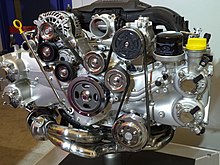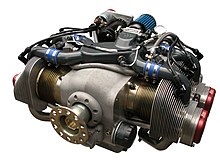Flat-four engine
This articlepossibly containsoriginal research.(December 2023) |

Aflat-four engine,also known as ahorizontally opposed-four engineorboxer engine,[1]is a four-cylinderpiston enginewith two banks of cylinders lying on opposite sides of a common crankshaft. The most common type of flat-four engine is theboxer-four engine,each pair of opposed pistons moves inwards and outwards at the same time.
A boxer-four engine has perfect primary and secondary balance, however, the two cylinder heads means the design is more expensive to produce than aninline-four engine.There is a minor, secondary unbalanced rotational torque pulse in the plane of the pistons, when a piston pair at one end of the engine is at TDC and the other pair at BDC. The TDC pair creates a torque greater than the BDC pair, so the net unbalanced torque pulse is the difference. The difference in TDC vs BDC inertial forces is explained in theEngine balancesection. Boxer-four engines have been used in cars since 1897, especially by Volkswagen and Subaru. They have also occasionally been used in motorcycles and frequently in aircraft.CessnaandPiperuse flat four engines fromLycomingandContinentalin the mostcommon civil aircraftin the world - theCessna 172,andPiper Cherokee,while manyultralightandLSAplanes use versions of theRotax 912.
Design
[edit]
In a flat-four engine, each pair of opposingpistonssuccessively moves inwards together and outwards together. The advantages of the boxer-four layout are perfect secondary vibration (resulting in minimal vibration), a lowcentre of gravity,and a short engine length. Flat-four engine have successfully usedair cooling,although air-cooled engines are noisier and have a lower power output than an equivalent engine withliquid cooling.In light aircraft, where lightness is of primary importance, air-cooling has traditionally been common.[2]
The downsides of boxer-four engines (compared with inline-four engines) are their extra width, the increased costs associated with having two cylinder heads instead of one, and the long exhaust manifold required to achieve evenly spaced exhaust pulses.[3]Due to these factors,inline-four enginesare more common in cars than are flat-four engines, andV6 enginesare often used where larger displacements are required.[4]
Engine balance
[edit]The equal and opposing forces generated in a boxer-four engine result in perfectsecondary balance(unlike the unbalanced vertical forces produced by inline-four engines). Boxer-four engines are therefore better suited to displacements above 2.0 L (122 cu in), since they do not requirebalance shaftsto reduce the secondary vibration.
In a boxer engine, each cylinder is slightly offset from its opposing pair due to the distance between thecrankpinjournals. This offset gives rise to a slightrocking couple,[5]: 27 but any resulting vibration is normally insufficient to require balance shafts.
As with all four-stroke engines of four cylinders or less, the lack of overlap in thepower strokesresults in a pulsating delivery of torque to theflywheel,causing a torsional vibration along the crankshaft axis.[6]Such vibration, if excessive, may be minimised using aharmonic damper.
Exhaust manifold
[edit]The typical firing order for a boxer-four engine is for the left bank of cylinders to ignite one after another, followed by the right bank of cylinders (or vice versa), with thefiring intervalevenly spaced at 180 degrees. Traditionally, the exhausts from the two cylinders on each bank were merged, with the resulting uneven exhaust pulses causing a characteristic "flat-four burble" exhaust sound.
The other common exhaust configuration (such as used by Subaru since the mid-2000s) is to pair the cylinders with a firing interval offset of 360 degrees, in order to optimise theexhaust pulses.[7][8][9]This configuration requires long exhaust manifolds, in order to pair the cylinders on opposite banks, and results in a less distinctive exhaust sound.
Use in automobiles
[edit]1900–1935
[edit]
In 1900, the first flat-four engine was produced byBenz & Cie,based on Benz's 1897 "contra" flat-twin engine.[citation needed]This engine was used in Benz racing cars, produced 20 hp (15 kW), had a displacement of 5.4 L (330 cu in) and was designed by Georg Diehl.
London companyWilson-Pilcherreleased its first car in 1901, which was powered by a flat-four engine. This engine was mounted longitudinally in the chassis, water-cooled, produced 9 hp (7 kW) and had a displacement of 2.4 L (146 cu in). Unusually for its day, the bore and stroke were equal, with each being 95 mm (3.7 in).
In 1902 the Buffum automobile was equipped with opposed four cylinder engines that were rated at 16 horsepower. Herbert H. Buffum produced an American Automobile called the Buffum in Abington, Massachusetts from 1903 to 1907.[10]
Having previously produced flat-twin engines, the 1926Tatra 30was the Czech company's first model powered by a flat-four engine. Tatra produced various flat-four engined model through the 1920s and 1930s.
1936–1999
[edit]This sectionneeds additional citations forverification.(December 2023) |
The 1936Tatra T97pioneered the rear-engined, air-cooled flat-four, backbone chassis layout (later used by theVolkswagen Beetle), and at the same time, though unrelated, came theSteyr 50from Austria, sporting a front boxer 4 engine with rear wheel drive. Also in 1936, English companyJowettexpanded its model range from flat-twin engines to also include flat-four engines. Production of Jowett flat-four engines continued until 1954, when theJowett Javelinsaloon andJowett Jupitersports models ended production.
The longest production flat-four engine is theVolkswagen air-cooled engine,which was produced from 1938 until 2006 and was most famously used in the rear-engined 1938–2003Volkswagen Beetleand 1950–1983Volkswagen Transporter.[11]This air-cooled engine was designed by Porsche and was also used in the 1948–1965Porsche 356,1953–1956Porsche 550,1965–1969Porsche 912and 1969–1976Porsche 914.In 1984, to comply with exhaust emissions regulations a water-cooled version called theVolkswagen Wasserboxerwas introduced in theVolkswagen Transporter (T3)
During the 1960s and 1970s, several manufacturers produced flat-four engines including the air-cooledCitroën flat-four engine,the water-cooledAlfa Romeo flat-four engine,the water-cooledLancia flat-four engineand the water-cooledSubaru EA engine.
Two important engines designed during this period, but never saw the light of day in series production, were the Morris 800cc side valve engine by Alec Issigonis in 1947 originally destined for the Morris Minor, and the Ferguson 2.2 litre SOHC engine by Claude Hill in 1966 as part of the R5 vehicle research project.
2000–present
[edit]
By 2000, most manufacturers had replaced flat-four engines with inline-four engines. A notable exception is Subaru, with the water-cooledSubaru EJ enginebeing available in turbocharged form in theSubaru WRXsports sedan and itsWorld Rally Carcounterpart. Subaru's adoption ofall-wheel drivewas a factor in retaining the flat-four engine, since the shorter length of this engine assists in fitting the all-wheel drive components into the chassis.[12]Although it is more expensive than an inline-four engine, the flat-four engine allows Subaru to build an all-wheel drive vehicle at little extra cost from two-wheel drive.[12]
In 2012, a naturally aspirated version of theSubaru FA enginewas used in theToyota 86(also called the "Subaru BRZ" and "Scion FR-S" ) rear-wheel drive sports coupe.[13]This engine is water-cooled, hasgasoline direct injection,produces 147 kW (197 hp) and has a displacement of 2.0 L (122 cu in).
The 2016Porsche Boxster/Cayman (982)mid-engined sports cars downsized from a naturally aspirated flat-six engine to a turbocharged flat-four engine, Porsche's first flat-four since the mid-1970s. This engine is produced in displacements of 2.0–2.5 L (122–153 cu in) and produces up to 365 hp (272 kW).[14]Several reviewers criticised the Boxster/Cayman for an uninspiring engine sound.[15][16][17]
Use in motorcycles
[edit]
Most motorcycles with four-cylinder engines use aninline-four enginelayout, however, several flat-four engine engines have been used inshaft drivemotorcycles:
- 1938–1939Zündapp K800(air-cooled)
- 1974–1987Honda Gold Wing(liquid-cooled)
- 1955–1956Wooler 500cc(air-cooled)
- 1981–1982BFG 1300,using the air-cooledCitroën flat-fourcar engine. Approximately 450 were built, with one quarter of these purchased by the French police.[18][19]
Use in aircraft
[edit]
Light aircraftcommonly use flat-four engines with displacements up to 6.4 L (390 cu in) from manufacturers such asLycoming Engines,Continental MotorsandFranklin Engine Company.
Forradio-controlled aircraft,flat-four engines with displacements of 40–50 cc (2.4–3.1 cu in) are produced by companies such asO.S. Engines.
A notable recent flat-four aero-engine is theside-valveBelgianD-Motor LF26.[20]Although the side-valve format has long been abandoned for most automotive applications because its combustion chamber is a bar to high enginerpm,the massively over-square (1.295:1) D-Motor is a very simple, low-revving, compact, reliable lightweight aero-engine (without the heavy complication ofohvvalve-gear)[21]
See also
[edit]References
[edit]- ^The so-called "boxer" configuration appears somewhat like bo xing competitors punching their gloves together before a fight
- ^Established manufacturers of such air-cooled aero-engines includeLycomingandContinental.
- ^Nunney, M. J. (2007).Light and Heavy Vehicle Technology.Butterworth-Heinemann. p.13.ISBN978-0-7506-8037-0.
- ^Engine article[1]
- ^Wilson, Hugo (1995). "The A–Z of Motorcycles".The Encyclopedia of the Motorcycle.London, UK: Dorling Kindersley.ISBN0-7513-0206-6.
- ^Thomson. Vibration Theory and Applications. p. 190. Dynamics of reciprocating forces. Prentice Hall Inc., USA, 1965.
- ^Announcement on Legacy exhaust in Japanese:"Fuji Heavy Industries, Press Information".2003-05-23. Archived fromthe originalon 2016-05-15.Retrieved2013-12-16.
- ^Announcement on Forester exhaust in Japanese:"Fuji Heavy Industries, News Release".2005-01-27. Archived fromthe originalon 2016-03-04.Retrieved2013-12-16.
- ^Announcement on Impreza exhaust in Japanese:"Fuji Heavy Industries, News Release".2007-06-05. Archived fromthe originalon 2016-03-09.Retrieved2013-12-16.
- ^"The Buffum Automobile".Farber and Associates. Archived fromthe originalon 2019-04-23.Retrieved2019-10-27.
- ^"The engine that Benz built still survives".The Globe and Mail.29 April 2010.Retrieved1 September2019.
- ^abStepler, Richard (September 1994)."Preview Drive: Three Ways to Get a Grip".Popular Science.245(3): 44.Retrieved2011-10-23.
- ^Bonk, Aaron (2013-02-07) (2013-02-07)."How Boxer Engines Work, And Why You Should Care About Subaru's New FA20".Archived fromthe originalon 2014-02-27.Retrieved8 January2014.
{{cite web}}:CS1 maint: numeric names: authors list (link) - ^"Performance: The new 718 Boxster".Porsche. 2016.Retrieved2016-11-01.
- ^"2019 Porsche 718 Cayman".caranddriver.14 May 2019.Retrieved1 September2019.
- ^"Porsche 718 Cayman review – The entry-level Porsche punches above its weight".evo.co.uk.Retrieved1 September2019.
- ^"2017 Porsche 718 Cayman First Drive Review: Performance Trumps Sound".motortrend.Retrieved1 September2019.
- ^Julian Marsh (2000-06-10)."BFG and MF motorcycles".Citroenet.org.uk.Retrieved2011-12-06.
- ^Julian Marsh."GS & GSA boxer engine".Citroenet.org.uk.Retrieved2011-12-06.
- ^A modular variant of the LF26 is the 4-litreflat-sixD-Motor LF39
- ^Note: A low-revving engine is eminently suitable to drive a propeller, which is typically most effective at about 2,000 rpm. If a valve in a side-valve engine should stick open, it cannot hit the piston and cause engine failure; the engine will continue with just that cylinder inoperative. This is an important safety feature for aero-engines.


